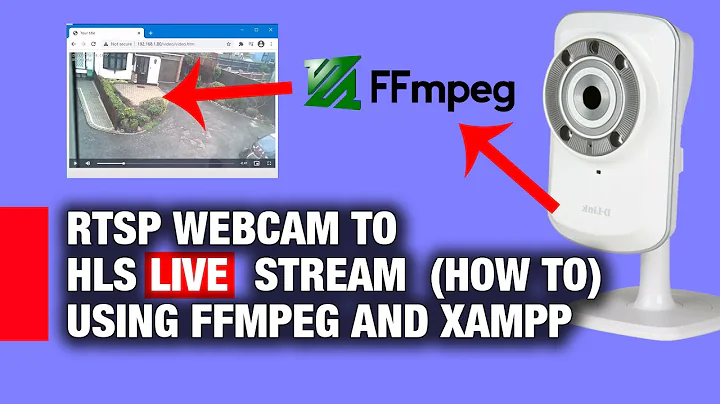How to stream with ffmpeg in a separate process
Solution 1
Probably it's trying to read stdin (ffmpeg actually takes interactive commands...). To disable that, ffmpeg has the -nostdin option—that should make it run in the background.
You could also consider -loglevel fatal or -loglevel error as well as a few other options to make it quieter (-nostats, etc.).
Solution 2
Redirecting stdin does the trick.
Use a command like: ffmpeg ... > output.log 2>&1 < /dev/null &.
-
> output.logRedirect stdout to output.log. -
2>&1Redirect stderr to stdout (so it ends up in the log file and not in the terminal). -
< /dev/nullRedirect stdin (which ffmpeg thinks it needs) to/dev/null(which gives an empty stream). -
&has the process run in the background.
Solution 3
As per PHP example on ffmpeg site, one should redirect input and both outputs to somewhere for ffmpeg to effectively run in the background:
ffmpeg -s 640x480 -f video4linux2 -i $CAM_PATH -f mpeg1video -b:v 800k -r 30 http://127.0.0.1:$FFMPEG_PORT/$VIDEO_PASSWORD/640/480/ -nostdin -nostats </dev/null >/dev/null 2>&1 &
The </dev/null >/dev/null 2>&1 bits do the trick.
Related videos on Youtube
Maxim V. Pavlov
Updated on September 18, 2022Comments
-
Maxim V. Pavlov over 1 year
I need to stream with ffmpeg on Ubuntu. The streaming should be started from a bash script.
Currently, I call ffmpeg like this, as a part of subroutine in a bash script:
function startFFMpegEncoder () { echo "Starting Encoder..." killall -9 ffmpeg ffmpeg -s 640x480 -f video4linux2 -i $CAM_PATH -f mpeg1video -b:v 800k -r 30 http://127.0.0.1:$FFMPEG_PORT/$VIDEO_PASSWORD/640/480/ & echo "Encoder started." }Here is an output that is produced by this part of the script's execution:
Starting Encoder... ffmpeg: no process found ffmpeg version N-73895-g323ec6b Copyright (c) 2000-2015 the FFmpeg developers built with gcc 4.8 (Ubuntu 4.8.4-2ubuntu1~14.04) configuration: --extra-libs=-ldl --prefix=/opt/ffmpeg --enable-avresample --disable-debug --enable-nonfree --enable-gpl --enable-version3 --enable-libopencore-amrnb --enable-libopencore-amrwb --disable-decoder=amrnb --disable-decoder=amrwb --enable-libpulse --enable-libdcadec --enable-libx264 --enable-libx265 --enable-libfdk-aac --enable-libvorbis --enable-libmp3lame --enable-libopus --enable-libvpx --enable-libspeex --enable-libass --enable-avisynth --enable-libsoxr --enable-libxvid --enable-libvo-aacenc --enable-libvidstab libavutil 54. 28.100 / 54. 28.100 libavcodec 56. 50.101 / 56. 50.101 libavformat 56. 40.101 / 56. 40.101 libavdevice 56. 4.100 / 56. 4.100 libavfilter 5. 25.100 / 5. 25.100 libavresample 2. 1. 0 / 2. 1. 0 libswscale 3. 1.101 / 3. 1.101 libswresample 1. 2.101 / 1. 2.101 libpostproc 53. 3.100 / 53. 3.100 [1]+ Stopped ffmpeg -s 640x480 -f video4linux2 -i $CAM_PATH -f mpeg1video -b:v 800k -r 30 http://127.0.0.1:$FFMPEG_PORT/$VIDEO_PASSWORD/640/480/ Encoder started.Why does the ffmpeg immediately gets stopped? Running ffmpeg in a separate terminal as a single command starts the broadcast for as long as there is an output trace in the terminal window.
-
Maxim V. Pavlov almost 9 yearsEven though these were an "on the point assumptions", actual solution is a bit different. Thank you very much though.
-
derobert almost 9 years@MaximV.Pavlov you can post your own answer explaining the solution you went with, to help future visitors to the site.
-
Maxim V. Pavlov almost 9 yearsSure, just did that, you are just too quick)
-
derobert almost 9 yearsMight want to send the output to a log file (or syslog) instead... Much easier to fix problems when the error messages aren't sent to /dev/null.



![[EN] FFmpeg RTSP to HLS live streaming without transcoding howto](https://i.ytimg.com/vi/mpZd2r5dqgM/hqdefault.jpg?sqp=-oaymwEcCOADEI4CSFXyq4qpAw4IARUAAIhCGAFwAcABBg==&rs=AOn4CLB2avKy044EO2wFj_s1SJsKARsXLg)

